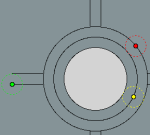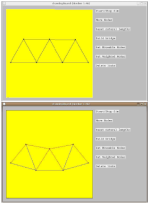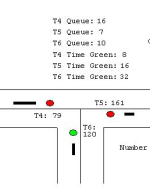The First Warwick Empirical Modelling Bulletin (WEB-EM-1) / 2004-5
Agent Based bridges [Paper  , Model
, Model  ]
]
This paper uses the medium of bridge modelling to present a critique of the methods of Empirical Modelling and those of the AgentSheets approach. The construction and modelling of bridges is interesting in the context as it presents some common challenges and points of interest within the field of EM. The individual bridges are constructed form similar elements however the elements must interact with each other in a manner which can be described in a number of ways which are relevant to the concepts of Agency and Dependency. The subject also invites application in the area of education and the use of such models in the context is considered. Keywords: Empirical Modelling, Agency, AgentSheets, Bridge.
EM and its Application to Human Biology [Paper  , Model
, Model  ]
]
This paper considers the use of Empirical Modelling as an aid in learning human biology. It is found that dependencies, one of the main concepts of Empirical Modelling have a strong correlation with relationships between organs. An EM model of the respiratory system is used throughout as a reference and a way to introduce the EM ideas. It is concluded that EM has very strong links with human biology and that its can be used as a tool to help students think about problems they encounter in the subject.
Modelling the IceCube approach to reconciliation of divergent replicas [Paper  , Model
, Model  ]
]
IceCube is a recent technology developed by Microsoft. Its purpose is to deal with the issue of reconciling divergent replicas of some shared system state, which can occur in e.g. multi-user concurrent systems. In other words, when users of a computer system each make modifications to a local copy of some global state, it is necessary at some point to merge these modifications in order to obtain some new, updated global state. Conflicts between local system updates can make the reconciliation complex or even impossible, and IceCube attempts to address this issue on an application-independent basis. Its algorithm relies heavily on the notion of constraints between modifications done by users. As these constraints have to be specified by the application programmer, the use of IceCube can be a very difficult task. This paper presents the argument that a model of the IceCube reconciliation process based on EM principles has applications both as an educational and an experimental tool.
Greedy Algorithms and the Making Change problem [Paper  , Model
, Model  ]
]
This paper discusses the development of a model which facilitates the understanding of the 'Making Change Problem,' an algorithm which aims to select a quantity of change using as few coins as possible. The paper introduces the Empirical Modelling approach to generating software for educational use and discusses its benefits due to its extensive scope for redefinition, customisation and extension.
Car interaction at Roundabouts [Paper  , Model
, Model  ]
]
This paper investigates the interaction between cars at roundabouts through the joint use of LSD specifications and a modelling study. In the study, the view of point an external observer is taken to investigate the dependencies in the actions of the various agents, which in this case are taken to be the cars rather than their driver. The paper goes onto discuss how the principals of empirical modelling that are demonstrated and gives a critique of Empirical Modelling in relation to alternative approaches to modelling.
Hunt the Wumpus: an Empirical Approach [Paper  , Model
, Model  ]
]
This paper discusses the use of Empirical Modelling in a Hunt the Wumpus game. Means of investigating the effectiveness of different inferences given different rules are discussed, as is the robustness of strategies if something unexpected occurs. Therefore, this is partly a study in Artificial Intelligence. The experimental approach taken with the model, however, suggests that it is also relevant to the area of Educational Technology, as the user of the model is encouraged to learn about the game and how to play it well by experimenting with strategies.
Emergency Vehicle simulation [Paper  , Model
, Model  ]
]
The purpose of this empirical modelling study is to model the scenario of three cars travelling along a straight road and responding to an emergency vehicle, considering not only the model itself but also the process of modelling undertaken and how this could be improved in the future. It will firstly be described how the modelling process was undertaken. We will then discuss the problems of specifying the model in the LSD notation and will suggest solutions to these problems. Finally we will consider the difficulties encountered creating the working model in the Eden environment and possible modifications to the modelling environment which could remove these difficulties in the future. It will specifically be considered how modelling multi-agent systems such as the one created in the model alongside this paper could be facilitated in the future both in by updating the specification methodology and the working modelling environment.
Grid Computing - an empirical perspective [Paper  , Model
, Model  ]
]
The intention of this paper is to critically evaluate the performance of the empirical perspective and tkeden toolkit with relevance to the creation of educational, decision support and simulation tools in the field of grid computing. A suitable model will be provided to demonstrate the major features of this philosophy and highlight several of its benefits as well as short comings.
Modelling traffic flow at traffic light controlled junctions [Paper  , Model
, Model  ]
]
In many places where heavy traffic can be a problem measures are introduced to try and ease the pressure on the roads to aid the flow of traffic around the road system. Some of the methods used involve: traffic lights, roundabouts, one-way systems and more dramatically bypasses completely avoiding the problem areas. Traffic lights are often used often at junctions or road intersections to aid the flow of traffic from different directions. The purpose of the lights is clear and the theory behind them is sound; meaning that at a particular junction vehicles should regularly flow through, minimising the queue build up in any one direction. In practice this is a different matter, multiple sets of traffic lights are often in sequence, affecting the flow of vehicles from one to the next. The key to obtaining the optimum traffic flow is to adjust the timings of the traffic lights at the junctions so that the whole block is in a sequence with each other. Another viewpoint of the traffic flow problem is how the vehicles on the road interact with each other and with the control measures such as roundabouts and traffic lights. The individual actions of a vehicle can affect the smooth flow originally intended from the road design. For example, changing lanes in heavy traffic can mean that one lane cannot move forward even though the road is clear ahead because of stationary traffic. When considering an appropriate model for representing the situation we can take the view of the vehicles and traffic flow measures (for example traffic lights) as agents that interact with each other, being individual (the car or traffic light) but dependent on each other (cars have to stop when a traffic light ahead is red). The proposal for the paper is to look into this claim and investigate the effects traffic lights have on the flow of traffic. A model can be constructed to show this and can be interacted with to explore the effects of changing the frequency at which the lights change, whether they changed at an equal rate and the rate of traffic approaching from each direction, with both vehicles and traffic lights as agents if desired. This also involves elements of concurrency as vehicles will independently move and traffic lights change, all at the same time.
An EM approach to Systems Modelling and Simulation [Paper  , Model
, Model  ]
]
This paper attempts to illustrate how systems modelling and simulation can be viewed from an empirical modelling perspective. A discussion on how the concept of agency and dependencies can be used in modelling physical properties of various artefacts seeks to demonstrate the potentials of empirical modelling in the field of engineering systems modelling. A case study involving a model of a pendulum is also presented which demonstrates the practical aspects of this theme.
EM for learning to understand numbers in non-decimal bases [Paper  , Model
, Model  ]
]
Instructionist and constructivist teaching methods are compared, and similarities and contrasts between constructivist learning theories of Ausubel, Papert and Kolb are examined. Problems with the current uses of technology in education, such as software inflexibility and rapid out-dating are discussed, and Empirical Modelling is proposed as a solution to some of these problems. The aims for the Tool to Aid Understanding of Non-decimal Numbers are then introduced, and its stage-by-stage development is documented with relation to educational theory.
Controlling robot arms [Paper  , Model
, Model  ]
]
At first glance, the modelling of a robot arm might seem an easy task. Indeed, much effort in this area seems to involve the machine-vision problem of determining the position of the arm with relation to the object of our interest. Once this problem of `target location' has been solved, the problem remains of moving the arm to that target position. This `secondary' problem of arm control is examined in this paper. Empirical Modelling offers us the opportunity to explore the control of a robot arm in the `ad-hoc' fashion, allowing various techniques to be tested in various situations, and to evaluate and compare their effectiveness. This paper also discusses possible enhancement of the current EM tools, (re)introducing a notion of object-enriched empirical modelling.
A practical study of modelling a highly generalised tournament [Paper  , Model
, Model  ]
]
In this paper I will document my attempt at creating a highly generalised model of the structure of a tournament. In doing so I will discuss the issues arrising (and some suggested solutions) when trying to create a data structure which is so highly generalised.
Bicycle drive chain simulation [Paper  , Model
, Model  ]
]
This paper discusses the application of Empirical Modelling to a simple mechanical simulation; a bicycle drive chain simulation. We look at the methods used to construct the model and some of the definitions used. Finally, we conclude by detailing the advantages and disadvantages of EM and any possible future developments.
Frisbee thrower and catcher simulation [Paper  , Model
, Model  ]
]
This paper shall describe how Empirical Modelling was used in constructing a small simulation of a frisbee game. The purpose of the paper is to publish why Empirical Modelling is distinct from other forms of software development. What makes it so different? For what reasons should Empirical Modelling be a widely accepted form of creating software artifacts? The document will state what aspects of Empirical Modelling were particularly useful in the construction of the frisbee model. How does Empirical Modelling help in constructing models in general? Does it help at all? If Empirical Modelling was not suitable for building the model, why not? Would these failings be important in the development of other models? The paper shall highlight how the development of the EM model would differ from the development of an object-oriented equivalent. Is there a noticable improvement over the current accepted way by which software is engineered?
A perspective on using EM for Concurrent Systems Modelling [Paper  , Model
, Model  ]
]
This paper explores the use of Empirical Modelling (EM) in modelling concurrent systems. This is often preformed with the use of formal mathematical techniques. The paper will concentrate on the use of EM techniques in allowing users to observe and interact with a concurrent system. In specific it will investigate the value of visualisation and the principles EM provides for developing concurrent systems with a comparison of the ability to view the system as an external observer and the role of visualisation with existing methods of modelling. To help identify the aspects looked at during the course of the paper, a model of a library system has been developed with reference to the key EM principles.

Modelling car interaction at roundabouts

Agent based bridges

Modelling a greedy algorithm for calculating change

Modelling traffic flow at light controlled junctions

Modelling a bicycle chain drive
